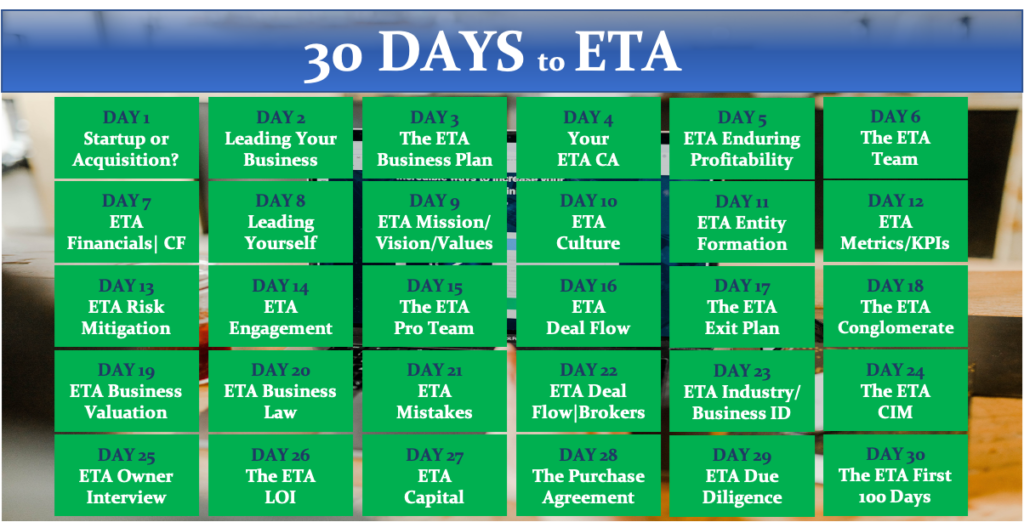My goal for this 30 Days to ETA Series is simply to walk you through the journey of sourcing, searching, and ultimately buying a business. However, make no mistake about this whole world of Mergers & Acquisitions… There is nothing “simple” about it! And in this Day #1 post we’ll explore whether as an Entrepreneur you should Startup or Acquisition — That is, should you start your own business from scratch (i.e., Startup) or buy a business that’s already in existence (i.e., Acquisition).
The Purpose of the 30 Days to ETA Series
If we want to take a trip, I’ll begin my travels with an end destination in mind. In order to leave my home in Las Vegas, Nevada to get to Seattle, Washington, we all know that I need to head northwest. But what route(s) should I take in order to get there? How will I be traveling to Seattle — Airplane, Car, Uber, etc.? It would be helpful if I had detailed directions from a GPS to outline the quickest route possible. Because of the distance between Las Vegas and Seattle, I’m more than likely going to run into delays and problems somewhere along my path — Wrecks, construction work, road closures, storms. Inevitably, my GPS will reroute me and get me to my final destination (I hope!)

Attend Webinar Workshop: 30 Days to ETA
Mapping out directions for my trip is no different than you acquiring a business. You see, from my perspective it’s a matter of knowing what you want to happen at the end that should determine your focus at the beginning. Are you building your business to pass it down to the next generation? Or are you growing your company to sell it for profit? Do you hope to sell a lucrative business to your employees or to another entrepreneur so that it will continue into perpetuity?
You can spend 40-80 hours a week, 50 weeks a year, for an entire career working for someone else in their business helping them achieve wealth… OR you can spend the same amount of time creating your own wealth!
Sam Palazzolo, Managing Director @ Tip of the Spear Ventures
The whole idea behind this series is to help you understand the purpose of your business so that you can sell it for profit. Surely you don’t want to make just enough money to get by while you run a company. Don’t you want to make tons of money while you work and then make millions of dollars when you sell it? Is that even possible? Is it actually possible for you to build a sellable business?
What Happens at the End of a Business?
According to the Exit Planning Institute, or the EPI, 80% of companies below 50 million dollars in revenue never sell. 80%. Another statistic tells us that only 30% of family businesses survive into the 2nd generation. Do you understand that — There’s only a 30% chance that you will pass your business down to your children or have some other type of succession plan! What will happen to your company then?
The EPI has two other revealing statistics:
- 75% of the business owners (who make less than 50 million dollars) who actually sell their business aren’t even happy that they did after all is said and done.
- Three out of four companies will be changing ownership in the next ten years.
It’s The Opportunity of a Lifetime
So why are 75% of businesses changing ownership? Well, the Baby Boomers who wanted to sell or get out of business years ago ran into the financial recession of 2008. They couldn’t get out profitably then, so they’ve been holding onto their companies until they could recuperate a profit or until they’re just too old to continue. And now that we’ve just come out (🤞) of the pandemic recession on 2020, those that made it through the financial recession could, once again, slug it out to get through this recession as well. However, most Economists look for them to exit.
This presents entrepreneurs with a huge opportunity, or as I like to call it the opportunity of a lifetime. With all these Baby Boomers exiting the economy, they’ll be leaving behind the companies that they lead. Unless they have a clear path for succession (Kids that want to take over the business, relations that care to run the organization, and/or staff that want to buy the business from them) they’ll have to look for external sources to purchase the business.
I Lead a Startup… I have no Hair as a Result!
So here in Day #1 of the Series, appropriately titled Startup or Acquisition you may be wondering why I’m not telling you to start a business (Startup) as opposed to buying one (Acquisition)? The reason is that buying a business is a much better path to successful entrepreneurship. Why? The Small Business Administration (SBA) sites that less than 2% of startups achieve a private equity exit. Furthermore, about 90% of startups fail. 10% of startups fail within the first year. Across all industries, startup failure rates seem to be close to the same. Failure is most common for startups during years two through five, with 70% falling into this category.
The technology startup I lead was one of the few that succeed (I guess I’m a 2%’er!) So if startups are not a good opportunity to flex your entrepreneur muscles, what is? In my mind, the answer is simple — Acquisition or Entrepreneurship Through Acquisition!
Sam Palazzolo



